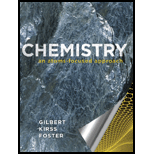
To find
We need to complete and balance the given chemical equations and write the net ionic equations.
Answer to Problem 8.65QA
Solution
a) Balanced equation:
Net ionic equation:
b) No precipitation reaction occurs.
c) Balanced equation:
Net ionic equation:
d) Balanced equation:
Net ionic equation:
Explanation of Solution
To balance the
To write a net ionic equation for a reaction in which the solid precipitates, we begin with a molecular equation, and then write the corresponding total ionic equation that includes all of the individual ions present in the solutions of soluble reactants and products. Eliminating the spectator ions yield the net ionic equation.
a) The complete chemical reaction is
Atoms:
The lead and sulfur atoms are already balanced. There are 2 Na on the left but only one on the right. To balance sodium, we place a coefficient of 2 in front of
Atoms:
Balanced equation:
According the solubility rules, all nitrate and sulfates are soluble in water except sulfate of Pb2+ cations; they are insoluble. So, they are written as separate ions in a total ionic equation. However, solid lead sulfate is written as
Eliminating the
b) When
Atoms:
Balance the Cl, H and O atoms to both side. Thus the complete balanced reaction is
Atoms:
According to solubility rules, all nitrates and NH4+ ions are soluble in water, so this will not form a precipitation reaction.
c) The complete chemical reaction is
Atoms:
Iron and sulfur atoms are already balanced, so let’s focus on sodium and chlorine. There are 2 Na on the left but only one on the right. To balance sodium, we place a coefficient of 2 in front of
Atoms:
Balanced equation:
The reactants are soluble ionic compounds, so they are written as separate ions in a total ionic equation, as is soluble
Eliminating the spectator ions
Net ionic equation:
d) The complete chemical reaction is
Atom:
All the atoms are already balanced. So the entire balanced equation is
The reactants are soluble ionic compounds, so they are written as separate ions in a total ionic equation, as is soluble
Eliminating the spectator ions
Conclusion
The reactions are balanced according to the law of conservation of matter and net ionic reactions determined from the solubility rules.
Want to see more full solutions like this?
Chapter 8 Solutions
Chemistry: An Atoms-Focused Approach
 ChemistryChemistryISBN:9781305957404Author:Steven S. Zumdahl, Susan A. Zumdahl, Donald J. DeCostePublisher:Cengage Learning
ChemistryChemistryISBN:9781305957404Author:Steven S. Zumdahl, Susan A. Zumdahl, Donald J. DeCostePublisher:Cengage Learning ChemistryChemistryISBN:9781259911156Author:Raymond Chang Dr., Jason Overby ProfessorPublisher:McGraw-Hill Education
ChemistryChemistryISBN:9781259911156Author:Raymond Chang Dr., Jason Overby ProfessorPublisher:McGraw-Hill Education Principles of Instrumental AnalysisChemistryISBN:9781305577213Author:Douglas A. Skoog, F. James Holler, Stanley R. CrouchPublisher:Cengage Learning
Principles of Instrumental AnalysisChemistryISBN:9781305577213Author:Douglas A. Skoog, F. James Holler, Stanley R. CrouchPublisher:Cengage Learning Organic ChemistryChemistryISBN:9780078021558Author:Janice Gorzynski Smith Dr.Publisher:McGraw-Hill Education
Organic ChemistryChemistryISBN:9780078021558Author:Janice Gorzynski Smith Dr.Publisher:McGraw-Hill Education Chemistry: Principles and ReactionsChemistryISBN:9781305079373Author:William L. Masterton, Cecile N. HurleyPublisher:Cengage Learning
Chemistry: Principles and ReactionsChemistryISBN:9781305079373Author:William L. Masterton, Cecile N. HurleyPublisher:Cengage Learning Elementary Principles of Chemical Processes, Bind...ChemistryISBN:9781118431221Author:Richard M. Felder, Ronald W. Rousseau, Lisa G. BullardPublisher:WILEY
Elementary Principles of Chemical Processes, Bind...ChemistryISBN:9781118431221Author:Richard M. Felder, Ronald W. Rousseau, Lisa G. BullardPublisher:WILEY





